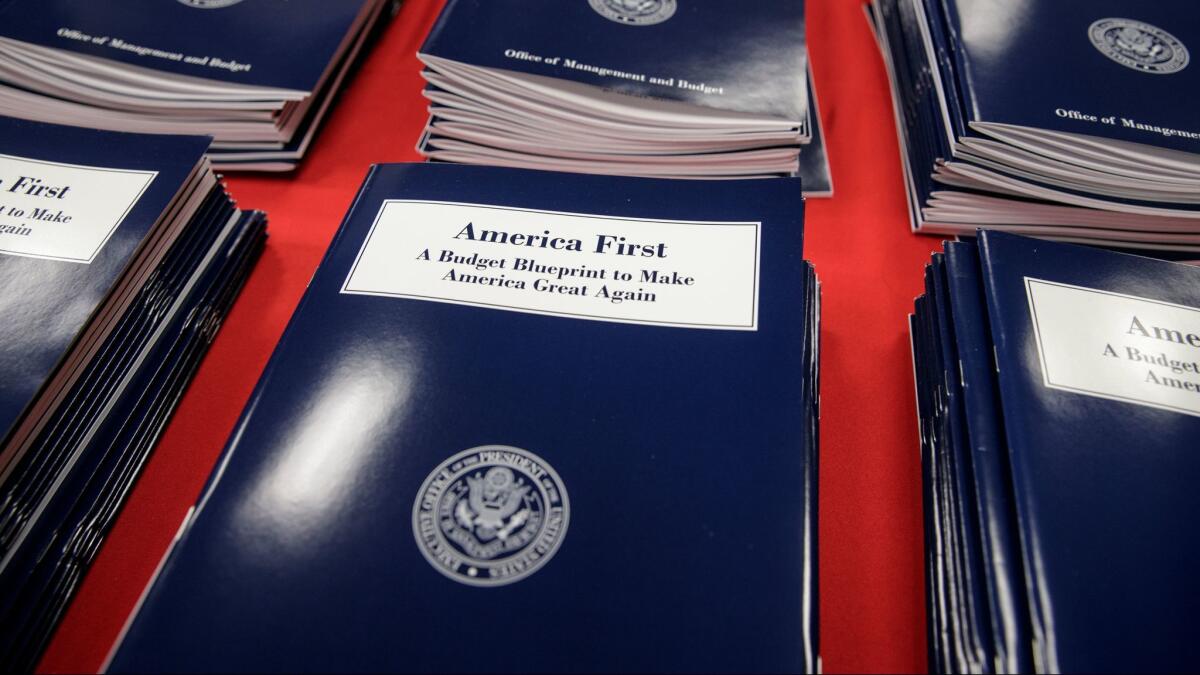Editorial: Trump’s budget proposal is a wish list of perennial GOP targets, only less realistic

In his opening salvo on the federal budget, President Trump proposes to undo the balance that lawmakers struck six years ago between defense and non-defense cuts as they struggled to rein in the deficit. Focusing first on the part of the budget that isn’t raising the tide of red ink, he would slash education, research, foreign aid and many domestic programs to make room for one of the biggest military buildups in history.
It’s such a Draconian approach and would inflict so much pain on lawmakers’ constituents — especially in Red State America — that Congress is expected to ignore most of Trump’s proposal. But that’s par for the course in Washington, where legislators hold the purse strings, and the big initiatives presidents lay out in their budgets rarely get funded.
The main purpose that these documents serve is to reveal the White House’s priorities. And no surprise, Trump’s top priorities are to indulge the Pentagon and the Department of Homeland Security while delivering a shock to the federal bureaucracy (and those who rely on the money it distributes).
Republican presidents have long sought to cut federal agencies and programs, so Trump’s proposal reads a bit like a wish list of perennial GOP targets. These range from relatively small programs, such as the ones supporting public broadcasters, the arts, Amtrak and legal aid for the poor, to major initiatives funding foreign aid, community development, education and scientific research.
No surprise, Trump’s top priorities are to indulge the Pentagon and the Department of Homeland Security while delivering a shock to the federal bureaucracy.
The reason those programs have endured over the years is because lawmakers see how much benefit they deliver to their constituents. But one hallmark of Trump’s proposal is how little heed it pays to the core role the federal government plays in addressing national priorities and needs that local communities can’t handle on their own. Instead, it would foist much of that work onto beleaguered state and local governments. That would be particularly problematic for the less populous, more rural states whose voters put Trump in the White House.
The administration proposed the cuts in order to finance a $54-billion increase in the defense budget for the fiscal year that begins Oct. 1 (on top of the additional $30 billion Trump wants to spend in the current fiscal year) and a roughly $3-billion increase in security efforts at home. “[T]his public safety and national security Budget Blueprint is a message to the world — a message of American strength, security, and resolve,” Trump wrote in the document’s introduction.
One might wonder why someone who campaigned against overseas American military entanglements would want to invest so much in updating and expanding military forces, equipment and weapons. But as Trump’s statement suggests, the proposed 10% increase in defense spending is about messaging strength, not necessarily using it, which is not an inherently bad thing.
Still, the defense and homeland security budgets are a poor proxy for U.S. “strength, security and resolve.” Those are simply investments in “hard power,” which is just one component of American leadership. At least as important is its “soft power,” which it exerts through diplomacy and a strong and growing economy. Trump’s budget reveals a deep skepticism in the value of diplomacy, in effect arguing that promoting stability and development around the world though foreign aid isn’t in Americans’ interests. On the contrary, that’s why we do it.
And while Trump argues that his proposal is fiscally responsible because it wouldn’t increase overall spending, his budget would reject the discipline that lawmakers from both parties agreed to impose on the Pentagon in equal measure to non-defense programs. That was a political compromise struck in 2011 in the face of burgeoning deficits (caused in large measure by the deep recession, which caused tax revenues to plummet while multiplying the demand for safety-net services), but it reflects more than just the demands of congressional Democrats. It’s also a recognition that Washington can’t bring the federal debt under control while continuing to grant the Pentagon its every wish. Just like every other federal agency, the famously wasteful Defense Department has to become more efficient to adapt to an era of higher healthcare costs, growing Social Security outlays and a lower ratio of workers to retirees.
California’s Democrat-dominated Legislature may comfort itself with the thought that Congress isn’t likely to show Trump’s budget proposals the deference it didn’t show his predecessors’. Nevertheless, they should start planning for leaner times in case Republicans in Washington start closing the spigot of federal aid, which accounts for more than a quarter of the state’s budget — most of it in Medi-Cal, the state’s version of the Medicaid program for poor and disabled Californians. Never mind that state residents typically pay more in federal taxes than the state collects in federal aid. The House GOP leadership’s proposal for Medicaid alone eventually could cut federal aid to California by as much as $20 billion, and that’s reason enough to start worrying.
Follow the Opinion section on Twitter @latimesopinionand Facebook
More to Read
A cure for the common opinion
Get thought-provoking perspectives with our weekly newsletter.
You may occasionally receive promotional content from the Los Angeles Times.






